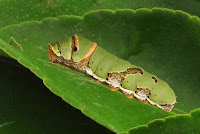<> Papilio demoleus (Linnaeus, 1758) <>
the Lime Butterfly ผีเสื้อหนอนมะนาว
Click on any photo to see all photos full size in Lightbox
Additions and corrections to the information provided on this page is always welcome. Please use the Contact form.
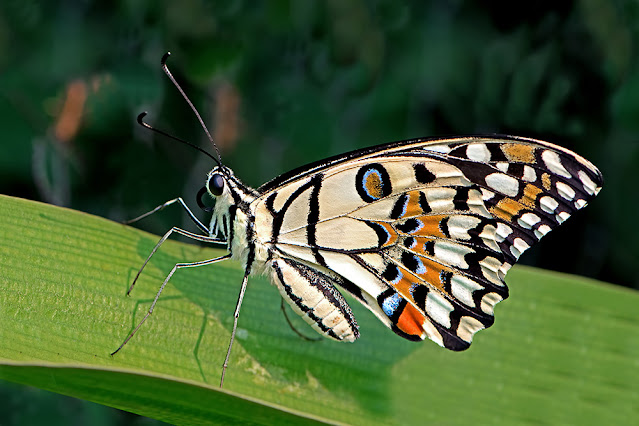
Photo taken at Doi Suthep-Pui National Park, Chiang Mai, Thailand 420m a.s.l.

Papilio demoleus is quite common and widespread across the whole of the South-East Asia region. They are avid nectar feeders and are often seen in urban parks and gardens. They are strong and rapid fliers. Males and females of this tailless swallowtail are very similar in appearance and they can be quite difficult to distinguish in the field, especially if you are only able to see the underside of the wings. If you are lucky enough to get a dorsal view it can be possible to determine the sex from the red/orange tornal spot on the hindwing. Basically, the black area between the red and light blue scales further up is generally larger on the female. Also, the end of the abdomen is slightly pointed on the male and rounded on the female.
This species is multivoltine and there can be up to 8 broods per annum. The adult female lays approx. 50 eggs in total, in batches of up to 10 at a time. The voracious larvae feed mostly on citrus trees and are therefore considered a pest in some areas. In their early stages they are brown in colour with blobs of white and have been described as resembling bird droppings. They do however undergo a complete transformation in the final instar when they turn green and have a much more pleasing appearance.
Synonyms: Papilio erithonius, Papilio epius, Papilio demoleinus, Princeps demoleus
Taxonomy: Animalia - Arthropoda - Insecta - Lepidoptera - Papilionidae - Papilioninae - Papilio - demoleus
Regional subspecies: Papilio demoleus demoleus (India, Bangladesh, N.Myanmar, N.Vietnam, S.China), P.demoleus libanius (Taiwan, Philippines), P.demoleus malayanus (S.Myanmar, Thailand, Laos, Cambodia, Vietnam, Malaysia, Singapore, Indonesia).
Regional Distribution: India, Nepal, Bhutan, Bangladesh, Myanmar, Thailand, Laos, Cambodia, Vietnam, China, Taiwan, Malaysia, Singapore, Indonesia, Philippines
 |
| Lamnamkok National Park, Chiang Rai, Thailand ♂ 450m a.s.l. |
Habitat: Papilio demoleus has a very diverse range of habitats, including deciduous forest, grassland, hill slopes, agricultural areas, and urban parks & gardens. It has been recorded at low to moderate elevations up to 2750m a.s.l.
Flight time: all year depending on location Wingspan: 70-90mm
Life History: egg 3-4 days instar 1 2-3 days instar 2 2-3 days instar 3 2-3 days instar 4 2-3 days instar 5 4-5 days pupa 9-14 days Total egg to adult 24-38 days
All times are approximate and can vary depending on the season and on the host used.
Larval Hosts: Acronychia pedunculata, Aegle marmelos, Atalantia buxifolia, Atalantia ceylanica, Bergera koenigii, Citrus x aurantium, Citrus x aurantifolia, Citrus hystrix, Citrus japonica, Citrus x limon, Citrus maxima, Citrus medica, Clausena anisata, Clausena excavata, Clausena heptaphylla, Clausena lansium, Euodia hortensis, Feroniella lucida, Glycosmis parviflora, Glycosmis pentaphylla, Limonia acidissima, Ruta graveoleus, Skimmia sp., Triphasia trifolia, Zanthoxylum ailanthoides, Zanthoxylum asiaticum, Zanthoxylum nitidum, Zanthoxylum scandens (Rutaceae), Cullen badocanum, Cullen corylifolium, Psoralea pinnata (Fabaceae), Limahlania crenulata (Gentianaceae), Manilkara hexandra (Sapotaceae), Ziziphus jujuba, Ziziphus mauritiana (Rhamnaceae), Magnolia champaca (Magnoliaceae).
Actual host plant used depends upon location and availabilty of plant species.
Adult Food Sources: Nectar - Duranta erecta, Lantana camara, Stachytarpheta indica (Verbenaceae), Ixora coccinea, Mussaenda frondosa, Spermacoce hispida (Rubiaceae), Caesalpinia pulcherrima, Libidibia coriaria, Pterocarpus macrocarpus, Tephrosia purpurea (Fabaceae), Ageratina adenophora, Chromolaena odorata, Cosmos caudatus, Crassocephalum crepidioides, Dahlia imperialis, Helianthus annuus, Tithonia diversifolia, Tridax procumbens, Zinnia elegans (Asteraceae), Moringa oleifera (Moringaceae), Ehretia aspera, Trichodesma indicum, Varronia cylindristachya (Boraginaceae), Asystasia gangetica, Pseuderanthemum maculatum (Acanthaceae), Clerodendrum paniculatum, Platostoma axillaris, Premna serratifolia, Vitex negundo (Lamiaceae), Antigonon leptopus (Polygonaceae), Carissa carandas, Catharanthus roseus, Nerium oleander (Apocynaceae), Pedalium murex (Pedaliaceae), Cestrum aurantiacum, Solanum mauritianum (Solanaceae), Rhododendron arboreum (Ericaceae), Abutilon hirtum, Urena lobota (Malvaceae), Hypericum mysurense (Hypericaceae), Acacia mearnsii (Mimosaceae), Cuphea hyssopifolia (Lythraceae), Jatropha integerrima (Euphorbiaceae), Citrus medica (Rutaceae), Bougainvillea glabra (Nyctaginaceae). Other - mud puddling, animal dung
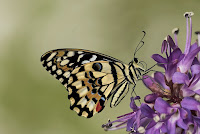 |
| Phnom Kulen, Siem Reap, Cambodia ♀ |
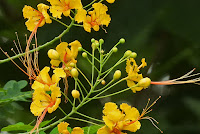 |
| Caesalpinia pulcherrima, a nectar source |
 |
| Ageratina adenophora, another nectar source |
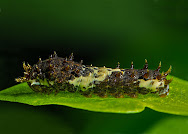 |
| third or fourth instar larva, from above it looks like bird poo |
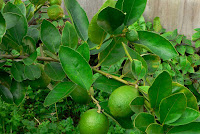 |
| Citrus x aurantifolia, a popular larval host |
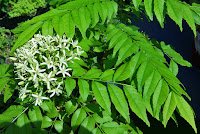 |
| Bergera koenigii, another larval host |
Links to other pages in this series for species in the same subfamily


